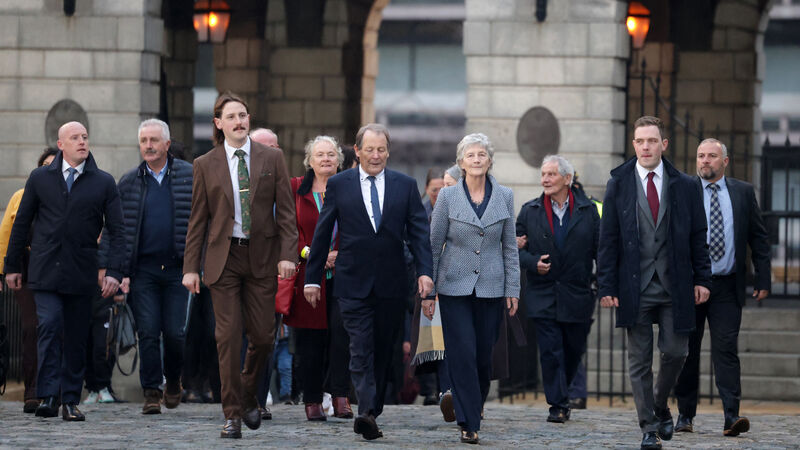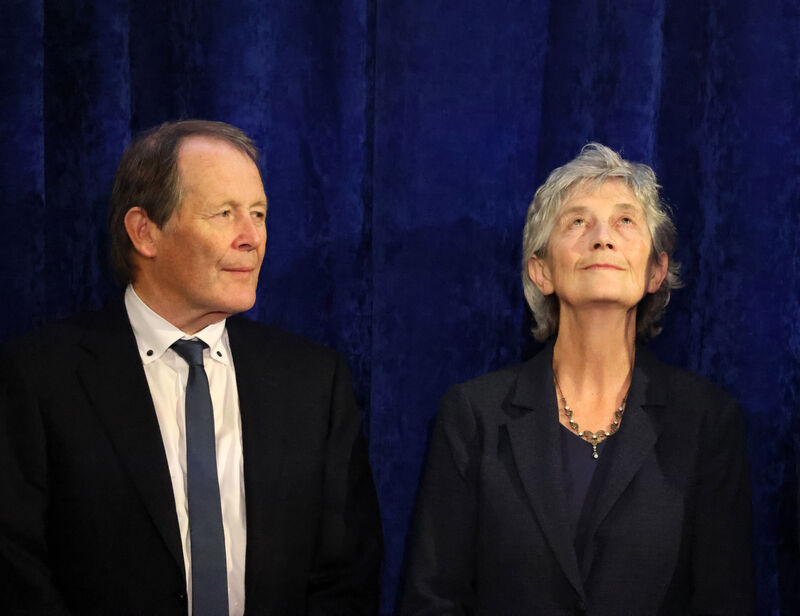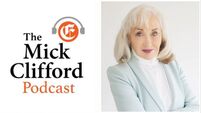Mick Clifford: Catherine Connolly rises from respected fringe figure to Ireland's first citizen

Catherine Connolly, with members of her family and supporters, at Dublin Castle ahead of her victory in the presidential election. Picture: Leah Farrell/© RollingNews.ie
Catherine Connolly thoroughly deserves her victory in being elected the 10th president of Ireland.
The margin of her victory was historic. Her campaign was professional and innovative, but that was decisive only because she was a really good candidate. And those who were up against her — Heather Humphreys and, formerly, Jim Gavin — simply were not.
She also had luck on her side, through fate and the incompetence of the government parties in particular. But you can only beat what’s in front of you, and that she did in some style. At least a week out from Friday’s poll, she was, in all but name, conducting a victory parade.
While the manner of her win was a triumph for the outsider over the establishment, a worrying feature of the result was the level of spoiled votes. In some areas, spoiled votes were running at 10 times their normal level.
Some of this is attributable to those who had supported Maria Steen’s efforts. A week before polling, there was a specific campaign to that effect launched by Declan Ganley and others.

The campaign appeared to be of the opinion that the larger parties, and the system in general, had an obligation to facilitate her entry on terms tailor-made for her.
There were also efforts from the far-right or ethno-nationalist element which is unable or unwilling to forward its own agenda through electoral politics and instead revert to disruption. Both of these strands of discontent have the potential to become toxic to basic democracy. Countering what ostensibly appears like complacency will require deep analysis, and it needs to be urgently addressed.
Despite that, the day of the count belonged to Connolly. One notable element to her success was the mobilisation of grassroots support. This was evident from early in the campaign when, on August 27, she attended an event in the Droichead Arts Centre in Drogheda. The theatre space was small, accommodating maybe 100 people. The number was probably swelled as her interviewer for the occasion was Vincent Browne.
Connolly was the only candidate in the race by that time. Mairead McGuinness, the favourite, had withdrawn, and her successor in Fine Gael hadn’t yet been selected. Jim Gavin was still a rumour. Sinn Féin was wrestling internally on whether to run its own candidate.
Yet Connolly was out there, ploughing through the electorate in narrow ridges, meeting small groups, doing the legwork togged out in runners and a leather jacket, and accompanied by a small, dedicated team.

Read More
That took a huge degree of self-belief and hard work. I wrote a piece on the interview in Drogheda, concluding with the lines: “This particular campaign, in which many of her probable opponents are still in the long grass, has a way to go. She is highly unlikely to implode. Beyond that, anything can happen.”
Few would have given her a serious chance at that point but, in the weeks that followed, plenty did happen. Gavin entered and exited the race. Fine Gael conducted a frantic, hurried process to replace McGuinness with Humphreys — which did little favours to the latter or the alternative party candidate, Sean Kelly.
At each small gathering, Connolly picked up not just voters but followers — many of whom signed up as volunteers, expanding eventually into the thousands.
Sinn Féin’s endorsement changed the whole electoral pitch, and Gavin’s exit reconfigured the field to deliver her a serious advantage.
She struck a chord with a youth vote disillusioned at the growing inter-generational divide in society. Her online campaign, particularly on podcasts, was streets ahead of anything other candidates had to offer.
However, it was her own quiet confidence and competent ability to sail through interviews and debates that was crucial.
On the other side of the ledger, she managed to survive an incident in which she and supporters sang 'Imagine' by John Lennon on Shop St in Galway, terrorising passers-by with a depth of cringe that was nothing short of chilling.
So much for the poetry with which she campaigned. The prose that she must deploy in office will probably disappoint those who saw her as leading some class of a movement into what was termed “a new republic”.
The president-elect is well aware of the limits of the office. She will be cognisant that her predecessor pushed out previous boundaries in commenting on various affairs of state through his personal political lens. However, Michael D Higgins grew into that role. In the early years of his first term, he tread relatively carefully.
One of the issues that the president-elect was vocal on during the campaign was neutrality. A major change to the interpretation of this State’s neutrality will arise in coming months when the government is scheduled to move to do away with the triple lock. If she comments on the issue in any manner, her term will be off to a controversial start.
If she doesn’t, her erstwhile supporters will be disappointed that she has sailed off into the mists of constitutional constraints cut loose from their political imperatives.
The political parties which supported her have been promoting the potential of alliances beyond this election. Wherefore art this “new republic” that they were all heralding during the campaign?
On one hand, the co-ordinated campaign was an antidote to the inability in the past of a broad left alliance to come together. Four broad entities — Sinn Féin, Labour, the Social Democrats, and People Before Profit/Solidarity — all drew in their individual constituencies for the greater goal. It worked extremely well.
Can it be the start of what some might call a beautiful relationship? Don’t bet the house on it. A common goal with an Independent candidate chasing a single office is one thing. Voting pacts, and strands of a joint policy platform across the spectrum, would be far more difficult.
Apart from that, any such alliance would require a commitment from all elements not to coalesce with the civil war parties irrespective of how seat numbers stack up after an election. Good luck with that.
For now, the focus is on the candidate who won the day. The victory has raised Catherine Connolly from a respected fringe figure, outside the party structure and well to the left of the electorate, into the highest office in the land. Fortune favoured her, and she made the most of the breaks. Now, we will see how she intends to be president for all the people.





